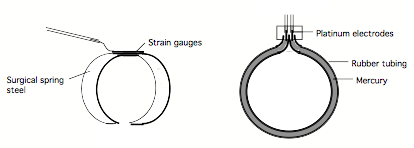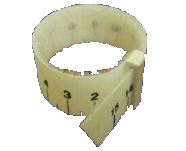Penile Circumference and condoms -Method - Measurements
Penile Circumference and condoms - Introduction
Penile Circumference and condoms -Method - Measurements
Penile Circumference and condoms - Method - Subjects and stimuli
Penile Circumference and condoms - Circumference of penis before sexual stimulus presentation
Penile Circumference and condoms - Circumference of penis after sexual stimulus presentation
Penile Circumference and condoms - Circumference of penis after sexual stimulus: grouped by response
Penile Circumference and condoms - Circumference of penis after sexual stimulus: grouped by age
Penile Circumference and condoms -Circumference of penis during sleep: grouped by response
Penile Circumference and condoms - Concluding remarks
Penile Circumference and condoms - Reference
Penile Circumference and condoms -Appendix: The Kinsey Data
2.1 Measurements
Physiological measures. In our studies on male sexual arousal we have made use of three different devices to measure penile circumference: the electromechanical strain gauge (Barlow et al., 1970), the Indium-Gallium strain gauge (Bancroft et al., 1966), and the Erectiometer.
The electromechanical strain gauge consists of two arcs of of surgical spring material with a pair of mechanical strain gauges at the junction (see Figure 1). Increases in penile circumference result in a flexing of the gauges and a corresponding change in resistance. A continuous electrical signal records changes in electrical output caused by expansion of the strain gauge. The gauge is calibrated using a 26-step plastic cone with known circumferences (ranging from 85 to 160 mm circumference). In the studies in which we used this gauge, subjects were asked to place it two-thirds of the way down the shaft of the penis toward the base.
< >
>
The Erectiometer is a 2 cm wide felt band, 19 cm long, with a sliding collar fastened to one end (see Figure 2). The band is calibrated in millimetres. The tighter the collar, the greater force is needed to expand the Erectionmeter. There are two types of the Erectiometer available: a yellow one (specified to require approximately 250 gm expansion force) and a green one (specified to require approximately 450 gm expansion force). In our studies we have used the yellow Erectiometer only. Furthermore, in the reported studies we used the Erectiometer concurrently with the mechanical strain gauge. Subjects were instructed to position the Erectiometer approximately two-thirds up the penile shaft from the base, and were asked to obtain their own readings of the Erectiometer.

As stated, the Erectiometer requires some force to expand. An advantage of this characteristic is that whenever a response is measured it involved at least some degree of penile rigidity. It should be noted however, that for the same reason the Erectiometer may slightly underestimate penile circumference during erection. The electromechanical and Indium-Gallium strain gauges may be unreliable at the upper end of the tumescence curve (Rosen & Beck, 1988). That is, these devices may overestimate circumference at high response levels. In a comparison study, we indeed found the two strain gauges (especially the electromechanical strain gauge) to sometimes overestimate absolute levels of erection. Furthermore, we found relatively large discrepancies between these two gauges (Janssen, Vissenberg, Visser, & Everaerd, in preparation). These characteristics are not likely to influence the results of experimental studies, i.e. when comparing the effects of various different manipulations. However, they point to some serious limitations if the gauges are used for determining the full range of penile capacity. For these reasons we have decided to report only on studies in which penile circumference data was obtained using the Erectiometer.
THE ERECTIOMETER
- Subjects placed the Erectiometer on the penis themselves
- The Erectiometer was positioned approximately on the middle of the penile shaft
- Subjects obtained their own readings
- Because the Erectiometer requires some force to expand, it probably provides for a conservative measure of penile circumference
Subjective measures. Discrete measures of subjective arousal, genital responses and emotional experience were collected prior to and during experimental sessions. For the purpose of this report we will describe only the measures of degree of erection as experienced by the subject. Subjects in study 1 and study 2 (see § 2.2) were asked to estimate their erectile responses on a 10-point scale, with the verbal labeled extremes 'no erection' and 'maximal erection'. Subjects in study 3 and study 4 were asked to assess their strongest genital response on a 6-point Likert scale (extremes: 'no genital sensations', 'full erection'). For the 10-point scales, erectile responses were categorised as follows: 1='no erection', 2-4='beginning erection', 5-7='partial erection', 8-10='full erection'. For the 6-point Likert scales, erectile responses were categorised as follows: 1='no erection', 2-4='beginning erection', 5='partial erection', 6='full erection'.
The Indium-Gallium strain gauge consists of a fine-bore rubber tube filled with Indium-Gallium, which is sealed at both ends with platinum electrodes (see Figure 1). A continuous electrical signal records changes in electrical output caused by expansion of the gauge. Calibration is accomplished using the same procedure as described for the mechanical strain gauge. This strain gauge is also positioned two-thirds of the way down the shaft of the penis toward the base.